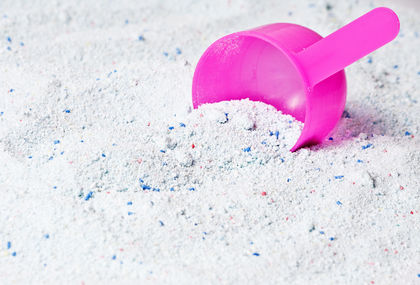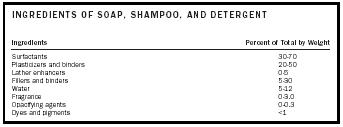Detergents

Soap and cleanliness are inseparable, and cleansing, be it personal hygiene or laundering, is part of human history. Stringent guidelines with regard to the cleanliness of holy sites are a part of all the major religions, and the sanctification of the state of cleanliness as well as its signification of purity of body and soul are recurrent themes in their liturgies.
The origins of the word "soap" and of the first use of soap are obscure. According to one Roman legend, soap was discovered serendipitously near Mount Sapo, an ancient location for animal sacrifice not far from Rome. Animal fat mixed with wood ashes (the ancient source of alkali) and rain-water created an excellent soap mixture. Roman housewives noticed that the strange yellow substance in the water of the Tiber River (flowing near Mount Sapo) made their clothes cleaner and brighter than ordinary water.
Soapmaking became an art among the Phoenicians (fl. ca. 600 B.C.E. ) and underwent significant advances in Mediterranean countries in which local olive oil was boiled with alkali ashes (as part of soapmaking) at around the same time.
Ascribing value to cleanliness seems to have been a part of the civilizing of humankind. After the fall of Rome (in 467 C.E. ), a decline in attention paid to personal cleanliness and the maintenance of sanitation contributed to the great plague of the Middle Ages, and made especially grim contributions to the Black Death plague epidemic of the fourteenth century. Cleanliness and regular bathing became unremarkable in much of Europe not until 300 years later.
For several centuries in Europe, soapmaking was limited to small-scale production that often used plant ashes containing carbonate ( esters of carbonic acid) dispersed in water, which were then mixed with animal fat and boiled until the water evaporated. The reaction of fatty acid with the alkali carbonate of the plant ashes formed a soap and glycerol.
The real breakthrough in soap production was made in 1780 by a French chemist and physician, Nicolas Leblanc, who invented the process of obtaining soda (sodium carbonate, Na 2 CO 3 ) from common salt (the Leblanc process), and increased the availability of this alkali at a reasonable cost. With the development of power to operate factories, soapmaking grew from a "cottage industry" into a commercial venture and became one of the fastest-growing industries of the modern era. Body soap, which had been a luxury item affordable by royalty and the very rich, became a household item of ordinary folks as well.
Throughout the nineteenth century, physicians were realizing the value of soap as a medicinal agent. A well-known protagonist of soap was scientist and educator Ignaz Phillipp Semmelweis, who in 1847 discovered the infectious etiology of puerperal fever and therefore required medical students to wash their hands before they examined patients. Semmelweis encouraged

| INGREDIENTS OF SOAP, SHAMPOO, AND DETERGENT | |
| Ingredients | Percent of Total by Weight |
| Surfactants | 30–70 |
| Plasticizers and binders | 20–50 |
| Lather enhancers | 0–5 |
| Fillers and binders | 5–30 |
| Water | 5–12 |
| Fragrance | 0–3.0 |
| Opacifying agents | 0–0.3 |
| Dyes and pigments | <1 |
his colleagues to adopt his antiseptic methods, telling them, "while we talk, talk, talk, gentlemen, women are dying. I am not asking anything world-shaking. I am asking you only to wash.… For God's sake, wash your hands." In a circular handed out in Budapest during the summer of 1865, he implored new mothers: "Unless everything that touches you is washed with soap and water and then chlorine solution, you will die and your child with you!"
The chemistry of soap manufacturing stayed essentially unchanged until World War II, at which time synthetic detergents (syndets) became available. There had been a search for cleansing agents that would foam and clean when added to seawater in response to the need of sailors who spent months at sea under severe freshwater restrictions.
The Chemistry of Soaps, Shampoos, and Laundry Detergents
Soaps, shampoos, and laundry detergents are mixtures of ingredients (see Table 1). The surfactants are the essential cleaning substances and they determine the cleansing and lathering characteristics of the soap, as well as its texture, plasticity, abrasiveness, and other features. Surfactants are compounds that have a dual affinity: They are both lipophilic and hydrophilic . A surfactant molecule consists of a lipophilic tail group, which links to greasy soil, and a hydrophilic and polar head group, which renders the molecule water-soluble; this arrangement helps to disperse and rinse away greasy soil. Variations in the balance between hydrophobic and hydrophilic features determine the use of the surfactant as a detergent, wetting agent , or emulsifier .
Surfactants are classified according to the nature of the hydrophilic head. There are four main classes: anionic, cationic, amphoteric, and nonionic. The first three refer to charged surfactant molecules. An anionic surfactant possesses a negative charge and needs to be neutralized with an alkaline or basic material in order for its full detergent capacity to be realized, whereas a cationic surfactant is positively charged and needs to be neutralized by an acid. Amphoterics include both acidic (negative) and basic (positive) groups, and nonionics contain no ionic constituents. "Natural" soap contains an anionic surfactant. The majority of surfactants that are used in personal cleansing bars and shampoos have anionic head groups.
It is noteworthy that almost all anionic surfactants are sodium or potassium salts of the negatively charged head groups; thus the advertising slogans "alkali free" and "soapless soap" are incorrect. Most soaps and shampoos contain a mixture of two to four surfactants (out of the thousands of synthetic surfactants that are currently available). In addition, there are innumerable plasticizers, binders, moisturizers, and fillers that are also used to formulate these soaps and shampoos. Creation of the formula of a soap is a complicated enterprise and it requires, in addition to a knowledge of chemistry and even engineering, both imagination and inspiration. The contemporary formulation of soaps is the result of research and development, as well as trial and error, carried out over a course of many years by research teams. It is as much art as it is science, and it requires a long learning experience.
The Process of Washing
The most obvious target of cleansing is the outermost layer of the skin, the keratinizing epithelium. It is a cornified (hardened) cell envelope and it has an extremely tough protein/ lipid polymer structure. This hard and lipophilic layer of the epidermis and the surface hairs would not easily retain dirt if it were not for a hydrolipid film that covers the outermost layer of skin and that picks up particles of soil. This natural outer film of lipid entraps and glues environmental dust, pollutants, smoke, keratinous debris, organic and inorganic compounds in sweat, cosmetics, and other substances that come in contact with it. The hair of the scalp (corresponding to a surface area of about 8 square meters, or 86 square feet, for an average female head) is cleansed regularly. The scalp gets coated with sebum, the product of the sebaceous appendages that flows into hair follicles and a natural lubricating oil that contributes luster to the hair, on the one hand, but entraps dirt, on the other.
Washing the skin consists of the removal of the outer layer of grease (lipid) in which the soil (no matter what kind) is embedded. It is a complex physicochemical process that includes the following:
- A weakening of the binding forces between the keratinized epithelium and the layer of grease via the reduction of the surface tension between the water and the water-resistant oil/grease. Because of this reduced surface tension, water (and surfactant molecules) can penetrate into the finest wrinkles of the skin. In this way, more and more interface is occupied by surfactant, and the adhesiveness of the soil-containing layer is further weakened, a process facilitated by mechanical rubbing.
- Transfer of portions of the layer of oil to the aqueous vehicle. It is facilitated by the action of the micelles created when the soil was emulsified. The micelles have negatively charged surfaces and are repulsed by the overall negative charge of the keratin of the skin epithelium.
- Dispersion/suspension of the oil and dirt particles in the soap foam, preventing these particles from being redeposited on the surface.
The Interaction of Soaps with the Skin
Surgeons need to scrub. Health-care providers and employees of food services must take a range of precautions against the dissemination of microorganisms. Very often, the simple act of washing one's hands is not fateful but nevertheless wise. Most experts in infection control and epidemiology maintain that hand washing remains the most powerful defense against infections. Germs are all around us, and can linger anywhere: the office phone, door handles, shopping baskets, money, even the button you push when you call for an elevator. You can unknowingly come into contact with germs. One simple rub of the eye or bite of a sandwich using unwashed hands can introduce any number of illnesses into your body. Hand washing reduces the risk. At the same time, most contemporary dermatologists agree that the comfortable classes have become preoccupied with cleanliness. Less, not more, washing is better for the skin. However, the irritant, toxic, and harmful effects of soaps have been exaggerated by some advertisers. (After all, what better way to promote their "mild," "nonallergenic," and "soapless" products?)
Washing with soap makes no discretely identifiable contribution to health. Its value lies more in the feeling it engenders in the user. People derive great enjoyment from washing: It gives them a tremendous sense of well-being.
SEE ALSO Bleaches ; Hair Dyes and Hair Treatments ; Leblanc, Nicolas .
Ronni Wolf
Bibliography
McCutcheon's 2003, Volume 1: Detergents & Emulsifiers. (2003). International Edition. Glen Rock, NJ: MC Publishing.
Spitz, Luis, ed. (1996). Soaps and Detergents: A Theoretical and Practical Review. Champaign, IL: AOCS Press.
Wolf, Ronni (1996). "Soaps, Shampoos, and Detergents." Clinics in Dermatology 14(1): 1–32.
Comment about this article, ask questions, or add new information about this topic: